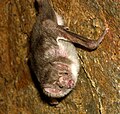Vampire
Vampire[edit]
A vampire is a mythical creature that subsists by feeding on the vital essence (generally in the form of blood) of the living. In European folklore, vampires are undead creatures that often visited loved ones and caused mischief or deaths in the neighborhoods they inhabited when they were alive. They wore shrouds and were often described as bloated and of ruddy or dark countenance, markedly different from today's gaunt, pale vampire which dates from the early 19th century.
Etymology[edit]
The term "vampire" was popularized in the early 18th century after an influx of vampire superstition into Western Europe from areas where vampire legends were frequent, such as the Balkans and Eastern Europe, although local variants were also known by different names, such as "vrykolakas" in Greece and "strigoi" in Romania.
Historical Background[edit]
Vampire legends have been recorded in many cultures around the world. The Mesopotamians, Hebrews, Ancient Greeks, and Romans had tales of demons and spirits which are considered precursors to modern vampires. However, it is the folklore of Eastern Europe that is most closely associated with the modern vampire legend.
Eastern European Folklore[edit]
In Eastern Europe, vampires were believed to be reanimated corpses that would rise from the grave to drink the blood of the living. The causes of vampirism were varied, including being bitten by a vampire, improper burial rituals, or being cursed. Methods of protection included garlic, holy water, and crucifixes.
Western Europe[edit]
The vampire superstition spread to Western Europe in the 18th century, where it was met with skepticism and fear. The first recorded accounts of vampire activity in Western Europe were from the 1720s, with the cases of Peter Plogojowitz and Arnold Paole in Serbia.
Literary Vampires[edit]
The vampire as we know it today began to take shape in the 19th century with the publication of works such as John Polidori's "The Vampyre" (1819), Bram Stoker's "Dracula" (1897), and Sheridan Le Fanu's "Carmilla" (1872). These works established many of the conventions of the vampire genre, including the vampire's aristocratic demeanor, its vulnerability to sunlight, and its aversion to garlic and holy symbols.
Modern Interpretations[edit]
In the 20th and 21st centuries, the vampire has become a staple of popular culture, appearing in films, television series, and literature. Notable examples include the "Twilight" series, "Buffy the Vampire Slayer", and "True Blood".
Related Pages[edit]
Gallery[edit]
-
The Vampire by Philip Burne-Jones
-
Vampire by Edvard Munch
-
Illustration of a vampire
-
Garlic, a traditional vampire deterrent
-
The Bible, often used in vampire lore
-
Holy water font
-
Vampire hunting kit
-
Grave suspected of containing a vampire
-
Vampire skeleton of Sozopol
-
Lilith by John Collier
-
Le Vampire
-
Dom Augustin Calmet, vampire scholar
-
Stilt house, similar to those in vampire folklore
-
Vampire illustration
-
The Irish Vampire
-
Common vampire bat
-
Varney the Vampire
-
Carmilla
-
Nosferatu
-
Bela Lugosi as Dracula
-
Jonathan Frid as Barnabas Collins
Ad. Transform your life with W8MD's Budget GLP-1 injections from $75


W8MD offers a medical weight loss program to lose weight in Philadelphia. Our physician-supervised medical weight loss provides:
- Weight loss injections in NYC (generic and brand names):
- Zepbound / Mounjaro, Wegovy / Ozempic, Saxenda
- Most insurances accepted or discounted self-pay rates. We will obtain insurance prior authorizations if needed.
- Generic GLP1 weight loss injections from $75 for the starting dose.
- Also offer prescription weight loss medications including Phentermine, Qsymia, Diethylpropion, Contrave etc.
NYC weight loss doctor appointmentsNYC weight loss doctor appointments
Start your NYC weight loss journey today at our NYC medical weight loss and Philadelphia medical weight loss clinics.
- Call 718-946-5500 to lose weight in NYC or for medical weight loss in Philadelphia 215-676-2334.
- Tags:NYC medical weight loss, Philadelphia lose weight Zepbound NYC, Budget GLP1 weight loss injections, Wegovy Philadelphia, Wegovy NYC, Philadelphia medical weight loss, Brookly weight loss and Wegovy NYC
|
WikiMD's Wellness Encyclopedia |
| Let Food Be Thy Medicine Medicine Thy Food - Hippocrates |
Medical Disclaimer: WikiMD is not a substitute for professional medical advice. The information on WikiMD is provided as an information resource only, may be incorrect, outdated or misleading, and is not to be used or relied on for any diagnostic or treatment purposes. Please consult your health care provider before making any healthcare decisions or for guidance about a specific medical condition. WikiMD expressly disclaims responsibility, and shall have no liability, for any damages, loss, injury, or liability whatsoever suffered as a result of your reliance on the information contained in this site. By visiting this site you agree to the foregoing terms and conditions, which may from time to time be changed or supplemented by WikiMD. If you do not agree to the foregoing terms and conditions, you should not enter or use this site. See full disclaimer.
Credits:Most images are courtesy of Wikimedia commons, and templates, categories Wikipedia, licensed under CC BY SA or similar.
Translate this page: - East Asian
中文,
日本,
한국어,
South Asian
हिन्दी,
தமிழ்,
తెలుగు,
Urdu,
ಕನ್ನಡ,
Southeast Asian
Indonesian,
Vietnamese,
Thai,
မြန်မာဘာသာ,
বাংলা
European
español,
Deutsch,
français,
Greek,
português do Brasil,
polski,
română,
русский,
Nederlands,
norsk,
svenska,
suomi,
Italian
Middle Eastern & African
عربى,
Turkish,
Persian,
Hebrew,
Afrikaans,
isiZulu,
Kiswahili,
Other
Bulgarian,
Hungarian,
Czech,
Swedish,
മലയാളം,
मराठी,
ਪੰਜਾਬੀ,
ગુજરાતી,
Portuguese,
Ukrainian


















